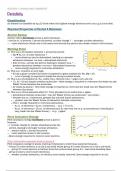Summary
Summary notes for AQA A-Level Chemistry Unit 3.2.1 - Periodicity
Summary notes for AQA A-Level Chemistry Unit 3.2.1 - Periodicity by an Imperial College London MSci Chemistry graduate. Notes divided into the following sections: Classification, Physical Properties of Period 3 Elements
[Show more]





